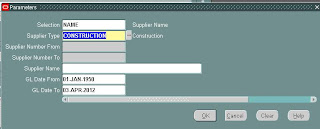Problem – Generate XML source for BI publisher report.
Solution – There is several options available to generate XML tags, intend as source for BI/XML publisher reports in EBS. One among those is use of data template.
Data Template is an xml file having predefined set of tags. Create a data template file and attach file at (XML Publisher Administrator (R) >> Data Definition >> Add Files >> Data Template)
Header
|
<?xml version="1.0" encoding="WINDOWS-1252" ?>
<dataTemplate name="XXXOALEARNING" dataSourceRef="ORCL_DB1" defaultPackage=”T1” version="1.0" >
|
Data Trigger
|
<dataTrigger name="beforeParameter" source="T1.beforeParameterFunction"/>
|
Parameter Section
|
<Parameters>
<parameter name="p_param1" datatype="number"/>
</Parameters>
|
Data Trigger
|
<dataTrigger name="afterParameter" source="T1.afterParameterFunction"/>
<dataTrigger name="beforeReport" source="T1.beforeReportFunction"/>
|
Query Section :
We can use multiple query here
|
<dataQuery>
<sqlstatement name="Q_EMP">
<![CDATA[SELECT empname From EMP WHERE empid=: p_param1]]>
</sqlstatement>
</dataQuery>
|
Data Structure :
XML tag generation.
|
<dataStructure>
<group name="G_EMP" source="Q_EMP">
<element name="EMPNAME" value="empname"/>
</group>
</dataStructure>
|
Data Trigger | <dataTrigger name="aftreReport" source="T1. aftreReportFunction "/> |
</dataTemplate>
Sample Data Template File
<?xml version="1.0" encoding="WINDOWS-1252" ?>
<dataTemplate name="XXXOALEARNING" dataSourceRef="ORCL_DB1" defaultPackage="T1" version="1.0" >
<Parameters>
<parameter name="p_user_id" datatype="number"/>
</Parameters>
<dataQuery>
<sqlstatement name="Q_USER">
<![CDATA[
SELECT user_id,
User_name,
FROM FND_USER
where
user_id=:p_user_id
]]>
</sqlstatement>
</dataQuery>
<dataStructure>
<group name="G_USER" source="Q_USER">
<element name="USERID" value="user_id"/>
<element name="USERNAME" value="user_name"/>
</group>
</dataStructure>
</dataTemplate>
Sample generated XML -
<?xml version="1.0" encoding="UTF-8" ?>
< XXXOALEARNING >
<P_CUSTOMER/>100 </P_CUSTOMER/>
<LIST_G_USER>
<G_USER>
<USERID>100</USERID>
<USERNAME>Sandeep</USERNAME>
</G_USER>
</LIST_G_USER>
</ XXXOALEARNING >















